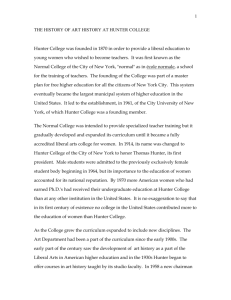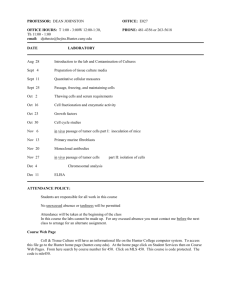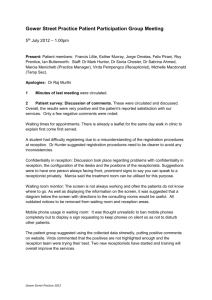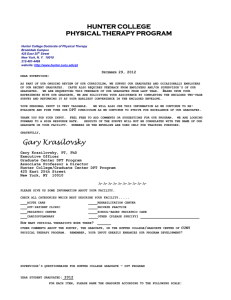Hunter IEP Low Incidence 2-26-13 - Big East Educational Cooperative
advertisement
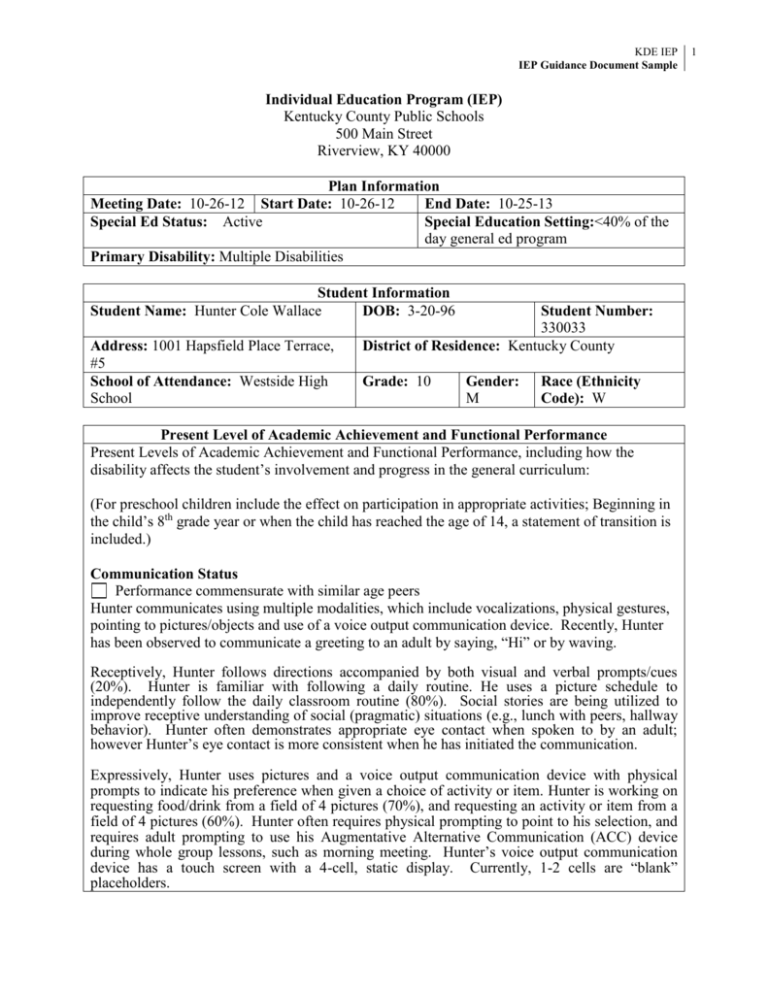
KDE IEP IEP Guidance Document Sample Individual Education Program (IEP) Kentucky County Public Schools 500 Main Street Riverview, KY 40000 Plan Information Meeting Date: 10-26-12 Start Date: 10-26-12 End Date: 10-25-13 Special Ed Status: Active Special Education Setting:<40% of the day general ed program Primary Disability: Multiple Disabilities Student Information Student Name: Hunter Cole Wallace DOB: 3-20-96 Address: 1001 Hapsfield Place Terrace, #5 School of Attendance: Westside High School Student Number: 330033 District of Residence: Kentucky County Grade: 10 Gender: M Race (Ethnicity Code): W Present Level of Academic Achievement and Functional Performance Present Levels of Academic Achievement and Functional Performance, including how the disability affects the student’s involvement and progress in the general curriculum: (For preschool children include the effect on participation in appropriate activities; Beginning in the child’s 8th grade year or when the child has reached the age of 14, a statement of transition is included.) Communication Status Performance commensurate with similar age peers Hunter communicates using multiple modalities, which include vocalizations, physical gestures, pointing to pictures/objects and use of a voice output communication device. Recently, Hunter has been observed to communicate a greeting to an adult by saying, “Hi” or by waving. Receptively, Hunter follows directions accompanied by both visual and verbal prompts/cues (20%). Hunter is familiar with following a daily routine. He uses a picture schedule to independently follow the daily classroom routine (80%). Social stories are being utilized to improve receptive understanding of social (pragmatic) situations (e.g., lunch with peers, hallway behavior). Hunter often demonstrates appropriate eye contact when spoken to by an adult; however Hunter’s eye contact is more consistent when he has initiated the communication. Expressively, Hunter uses pictures and a voice output communication device with physical prompts to indicate his preference when given a choice of activity or item. Hunter is working on requesting food/drink from a field of 4 pictures (70%), and requesting an activity or item from a field of 4 pictures (60%). Hunter often requires physical prompting to point to his selection, and requires adult prompting to use his Augmentative Alternative Communication (ACC) device during whole group lessons, such as morning meeting. Hunter’s voice output communication device has a touch screen with a 4-cell, static display. Currently, 1-2 cells are “blank” placeholders. 1 KDE IEP IEP Guidance Document Sample Hunter seldom independently initiates communication using his AAC device. Hunter typically initiates communication by approaching someone and touching them on the arm or hand. Currently, Phase 1 strategies of the Picture Exchange Communication System are being implemented (100% assistance from facilitator is required). Hunter’s preferred reinforces include music, books, singing, swinging, noise makers and his towel. When asked to point to a picture to answer a wh-question (i.e., “what’s next on your schedule?”), Hunter is able to do so from a field of 4 with 50% accuracy. When participating in a movement activity, Hunter will use physical gestures and vocalizations to request continuation of the activity (i.e., when pushed on a swing, then stopped, Hunter will lean forward and grunt to indicate his request for “more swinging”). Hunter’s parents have been trained on how to use his communication system and report that they provide Hunter with opportunities to practice communication skills, using the same instruction that is used at school. Hunter’s communication disability adversely affects his ability to participate within his educational program. It significantly affects his ability to develop age-appropriate social skills and friendships and to independently function within society. Academic Performance Performance commensurate with similar age peers As demonstrated on class instructional activities (daily class work), progress data and teacher observation, Hunter’s academic skills are well below average as compared to non-disabled, same age peers. Math According to teacher observation and progress data, Hunter continues to work on mathematic skills pertaining to both functional and general curriculum. Recent work samples indicate he can identify basic geometric shapes (square, circle, triangle) with 65% accuracy, but is unable to categorize the shapes based upon their properties. With assistance, Hunter has been collecting data from surveys given to classmates about their favorite sports and hobbies. Using this data, he is able to construct simple bar graphs using manipulatives (70%) with partial physical prompting. He is able to move blocks to the area of the bar graph in relation to counting, but is unable to answer “wh” questions related to these points. He has shown growth from 65% in the addition and subtraction of 1-digit numbers using manipulatives and can successfully perform either operation with 85% accuracy. Hunter shows growth from 70% to 80% in his ability to match price amounts ($1, $2, or $3) with the correct number of bills. Hunter has continued to work on the next dollar up strategy by showing him a price card with a given price and then being asked to touch the correct number of dollar bills he would use to make the purchase. At this time, he can select the correct price with 75% accuracy using a field of 4 on the ACC device. Hunter’s deficits in operational and problem solving skills inhibit his participation in general education activities and future life skills activities related to computation of money, his ability to generalize skills across settings, comprehend abstract concepts, and independently participate in all content areas and community environments. Reading 2 KDE IEP IEP Guidance Document Sample Based on progress data, Hunter can identify 60 Dolch sight words. He enjoys listening to adapted age appropriate books with peers. Hunter follows a visual picture schedule for his day. Hunter participates in reading comprehension activities and reading sight words taken from the general and functional curriculum by touching a picture card from a field of four (picture card has icon and word(s) together). Hunter will listen to an adapted grade level passage and answer literal comprehension questions. He is most successful in identifying main idea and main characters with 65% accuracy. At this time, he is at 35% accuracy with identifying other story elements such as setting and plot. He can identify twenty-five high-frequency functional vocabulary words (e.g., teachers names, building locations, subject name) pertaining to his daily schedule with 60% accuracy. In his content curriculum vocabulary pertaining to monthly science and social studies units, he identifies sight words with 50% accuracy. Hunter spends a portion of each week in the community to work on vocational and independent daily living skills. He can correctly identify ten common community and vocational vocabulary words (stop, exit, entrance, cart, cashier, dairy, produce, bakery, elevator, restroom) with 75% accuracy. Hunter’s need for adapted reading passages and inability to read and comprehend grade level reading passages impact his ability to independently participate in all content areas. Writing Using a simple sentence starter (I like…, I want…, I worked on…, I went) and an AAC device with touch screen and given a field of four choices, Hunter can correctly construct three sentences with 40% accuracy by touching the correct icon paired with familiar word from the given choices. In Language Arts, Hunter is currently working on a research project on percussion instruments. While he is able to identify different percussion instruments (drum, piano, xylophone), using a field of 4 on either picture cards on an ACC device, adult or peer assistance is needed in looking for information on the internet and in the school library. Though he can point to the object he is researching he cannot make sense of the researched information to communicate it in a unique way in typed format. Hunter’s inability to express independent thoughts without prompting or assistance impacts his ability to participate in all content areas and community environments. Health, Vision, Hearing, Motor Ability Performance commensurate with similar age peers Hunter is diagnosed with autism and ataxic cerebral palsy. Hunter has a history of seizures and requires medication at home and school. He walks with a wide base gait and good balance. Since he enjoys walking, this activity is used for instructional breaks, positive reinforcement, vocational routines, and social activities with peers. He shows some caution when navigating steps by holding onto the railing and onto an adult’s hand, but does not visually attend while walking. Therefore, standby assistance and/or contact-guard assistance may be necessary when navigating steps, curbs, and uneven terrain. Hunter’s gross range of motion, muscle strength, and symmetry were within normal limits. He can transfer independently from a standing position into a classroom chair. He demonstrates good posture while sitting in the chair. While he sits independently in a chair, he requires prompting to stay in the chair as required by the classroom activity. He uses a ball in his classroom and has a cushion in his classroom chair. He follows simple motor directions (e.g., open, hold, carry). Hunter shows a left hand preference for feeding and for fine-motor tasks. He makes marks on 3 KDE IEP IEP Guidance Document Sample paper using a wide marker or bingo dauber. He demonstrates poor visual attention to a given activity. Hunter is able to use adapted utensils and a scoop dish for feeding himself but requires physical cues to slow down. Hunter has decreased tactile discrimination and is noted to overstuff his mouth when eating. He requires assistance to prepare for meals (set up, cutting food, opening containers, etc.), clean himself and his eating area when finished. He often drops food on the table, self and floor. He prepares simple snacks with assistance. Hunter tends to seek movement and deep pressure to regulate his sensory system. He is given opportunities to bounce on a therapy ball in the classroom and to have movement breaks of walking. Hunter is often observed to give himself deep pressure by pushing on his head or grasping his hands tightly. He continues to work on improving his assistance with toileting. Hunter has difficulty visually tracking and demonstrating visual awareness of activities in the classroom. He does show avoidance of certain auditory input including loud pitched noises such as alarms or screaming. Hunter has difficulty imitating movements that are demonstrated by the teacher and avoids doing both gross and fine-motor activities. Parent reports that Hunter enjoys inversion and swinging at home. Hunter’s health and motor needs negatively impact his abilities and skills in the general and functional curriculum as well as his transition to community and postschool environments. Social and Emotional Status Performance commensurate with similar age peers Hunter is a very social young man and has become very social with his classmates and other familiar adults at school and in the community. Hunter will approach other individuals and will initiate a greeting by waving and saying, “Hi” or will respond to a greeting of “Hi,” “Hello,” or “Hey.” In group settings, he interacts most appropriately when he has the ability to move freely within a designated area (reading activity, gym, work site, cafeteria). He is making progress in turn-taking and is currently able to make three to five exchanges in a game situation with verbal and partial-physical prompting. He continues to work on improving his assistance with toileting. Currently, he wears undergarments and follows an hourly toileting schedule at school and at home. He currently has on average three accidents per week at school and at this time is unable to indicate to school staff when this has occurred. Hunter requires assistance with setting up his food at lunch in the cafeteria. He can feed himself but requires assistance. From time to time, he may require verbal reminders to slow down and chew his food. Hunter is able to complete a task if his attention is focused but requires verbal prompting to regain attention, and he may require physical prompting in order to regain attention. Hunter requires the task that he is working on to remain in his field of vision. He loves books, music, clapping, humming, and singing. Hunter requires much movement throughout the day and often prefers to participate in an activity while being allowed to balance on the ball. On an average of 5 times a day, Hunter demonstrates anxiety related behaviors such as scratching his face, slapping his thighs, and placing his hands over his mouth. Antecedents for these behaviors include large crowds, loud noises, and being required to remain attentive to an activity for a long period of time. Hunter utilizes a sensory diet with scheduled movement opportunities every thirty minutes. He benefits from a variety of calming strategies including bouncing on an exercise ball, playing a drum, and taking a walk. It is difficult to for Hunter to regain his focus once upset to the point of demonstrating selfinjurious behavior. Hunter needs adult verbal prompting to initiate calming activities during times of frustration 50% of the time. Hunter’s need for sensory supports across all settings impacts his ability to access and participate in the general curriculum and all community settings. 4 KDE IEP IEP Guidance Document Sample Hunter needs physical assistance; hand over hand, with grooming and hygiene. General Intelligence Performance commensurate with similar age peers According to the integrated assessment report, the administration of the WISC-IV yielded a fullscale IQ score of 40, which falls in the well below average range. He performs best at school when musical and kinesthetic teaching styles are incorporated into lesson activities. Hunter performs best when jobs and academic tasks are task-analyzed. Currently, he is able to independently perform familiar tasks using visual supports with three steps with 80% accuracy. Hunter uses an AAC and picture cards to participate in the functional and general curriculum, which has been modified and adapted. Hunter continues to work on his reasoning and problem-solving skills. He is dependent on adults to help keep him safe and participate in the curriculum as well as the everyday school environment. Hunter’s cognitive deficits and need for generalization of skills across settings impacts his ability to independently participate in all school and community environments. Hunter relies on adults to keep him safe. Transition Needs Not an area of concern at this time (Checking this box is not an option when the student is in the 8th Grade or 14 years or older because transition must be addressed for these students) Instruction Related Service Community Experience Employment Daily Living Skills Post School Adult Living Objectives Functional Vocational Evaluation Hunter is 16 years old and in the 10th grade. Hunter’s Multi-Year Course of Study is outlined through completion of high school and subsequent transition activities/programs. Based on a student picture survey with Hunter, teacher observation, and a parent survey with his mother and father, Hunter’s needs are in the areas of social skills, task completion, and general community functioning. Based on student and parent surveys, a career interest inventory, and teacher observation, Hunter enjoys being outside, interacting with peers, and music. He prefers activities that have predictable routines with a definite start and finish. He excels at tasks that are task-analyzed and require movement and heavy work. Instruction: Based on IEP progress data, Hunter can correctly identify twenty-five highfrequency classroom vocabulary words pertaining to his daily schedule with 70% accuracy. He demonstrates learning best when he has the opportunity to generalize skills across a variety of settings. Hunter will need continued instruction in the use of his AAC device across settings as well as increasing sight word vocabulary related to school and community environments. Hunter’s cognitive deficits will impact his ability to generalize skills in different settings and to access and participate in unfamiliar environments. Community Experiences: Hunter requires supervision and safety assistance when engaging in 5 KDE IEP IEP Guidance Document Sample instructional opportunities outside the school setting (e.g., shopping, banking, recreation). In order to generalize skills into community environments, Hunter needs community-based instruction which will enable him to practice skills in natural environments. Actual job training in the community through the Community-Based Work Transition Program is needed in order for Hunter to generalize work-related skills. Employment: Based on a career interest inventory and student survey, Hunter has demonstrated an interest in obtaining a job in the field of landscaping. IEP progress data indicates that he can correctly identify ten common community and vocational vocabulary words with 75% accuracy and also perform familiar tasks with three steps using visual supports with 80% accuracy. Hunter’s cognitive deficits will impact his ability to acquire new skills involving multiple steps in order to independently participate in vocational settings. Hunter will require supervision for attention and safety. Hunter will need supported employment assistance as he explores locations for jobs in landscaping as well as training of work-related skills for those particular locations. Daily Living Skills: Hunter requires assistance with all grooming and hygiene needs. With adapted utensils, he is able to feed himself, but needs assistance with cleaning up his area once he is finished. Parent survey indicates they are most comfortable with Hunter living in a supported living setting with 2-3 roommates. They also indicated that Hunter would like to participate in weekly personal shopping activities after he graduates. Hunter’s deficits in the area of daily living skills will impact his ability to live and perform personal care needs independently after high school. Functional Vision/Learning Media Assessment Not an area of concern at this time Consideration of Special Factors for IEP Development (The ARC must address each question below and consider these issues in the review and revision of the IEP) Does the child’s behavior impede his/her learning or that of others? Yes No If Yes, include appropriate strategies, such as positive behavioral interventions and supports in the statement of device and services below. Does the child have limited English proficiency? Yes No If Yes, what is the relationship of language needs to the IEP? Is the child blind or visually impaired? Yes No If Yes, the team must consider: Is instruction in Braille needed? Yes No Is use of Braille needed? Yes No Will Braille be the student’s primary mode of communication? Yes No (See evaluation data for supporting evidence) Does the child have communication needs? Yes No If Yes, please specify 6 KDE IEP IEP Guidance Document Sample below: See Present Levels for Communication Status Other (Specify): Is the child deaf or hard of hearing? Yes No consider: The child’s language and communication needs; Describe: See Present Levels for Communication Status Other (Specify): If Yes, the team must Opportunities for direct communications with peers and professional personnel in the child’s language and communication mode, academic level and full range of needs; Describe: Any necessary opportunities for direct instruction in the child’s language and communication mode. Describe: Are assistive technology devices and services necessary in order to implement the child’s IEP? Yes No If Yes, include appropriate devices in the ‘Statement of Devices/Services’ below. Statement of Devices/Services: If the ARC answered Yes to any of the above, include a statement of services and or devices to be provided to address the above special factors. See Specially Designed Instruction See Supplemental Aids and Services See Behavior Intervention Plan Other (Specify): Measurable Annual Goals and Benchmarks Annual Measurable Goal (#1): Given a total dollar amount (dollars and cents) between $1 and $10 on a price card, Hunter will touch the correct number of dollar bills that corresponds with the Next Dollar with 90% accuracy across 5 consecutive sessions. Method of Measurement: Direct Measure (teacher observation and frequency recording) Specially Designed Instruction: Instruction using system of least prompts Instruction using real $1 bills Modeling Community simulations in the classroom 7 KDE IEP IEP Guidance Document Sample Community-based instruction For the IEP to be in effect by the child's 16th birthday and thereafter: This annual goal will reasonably enable the student to meet the student's postsecondary goal in the area(s) of: Education/training Employment Independent living Benchmarks/Short Term Instructional Objectives 1. Given a total dollar amount (dollars and cents) between $1 and $5 on a price card, Hunter will touch the correct number of dollar bills that corresponds with the Next Dollar with 90% accuracy across 5 consecutive sessions. 2. Given a total dollar amount (dollars and cents) between $1 and $8 on a price card, Hunter will touch the correct number of dollar bills that corresponds with the Next Dollar with 90% accuracy across 5 consecutive sessions. 3. Given a total dollar amount (dollars and cents) between $1 and $10 on a price card, Hunter will touch the correct number of dollar bills that corresponds with the Next Dollar with 90% accuracy across 5 consecutive sessions. Annual Measurable Goal (#2): Given one of fifteen sight words from the functional (classroom high frequency words) or general curriculum monthly unit, Hunter will correctly identify the word, by touching a card with the picture from a field of four with 80% accuracy across 4 weekly consecutive sessions. Method of Measurement: Direct Measure (teacher observation and frequency recording) Specially Designed Instruction: Instruction using constant time delay Pre-teach vocabulary Selection of relevant sight words from monthly units Collaboration with parent to identify functional sight words from home setting For the IEP to be in effect by the child's 16th birthday and thereafter: This annual goal will reasonably enable the student to meet the student's postsecondary goal in the area(s) of: Education/training Employment Independent living Benchmarks/Short Term Instructional Objectives 1. Given one of five sight words from the functional curriculum (classroom high frequency words), Hunter will correctly identify the word, by touching a card with the word and picture from a field of three with 80% accuracy across 4 consecutive sessions. 2. Given one of five sight words from the general curriculum monthly unit, Hunter will correctly identify the word, by touching a card with the word and picture from a field of three with 80% accuracy across 4 consecutive sessions. 3. Given one of five sight words from the community setting, Hunter will correctly identify the word, by touching a card with the word and picture from a field of three with 80% 8 KDE IEP IEP Guidance Document Sample accuracy across 4 consecutive sessions. Annual Measurable Goal (#3): Given a routine sentence starter (I like…, I worked on…, I went to…, etc.) By choosing to use his ACC device or pointing, Hunter will select the word, with accompanying picture from a field of four that accurately reflects an activity that took place that day with 80% accuracy across 4 consecutive sessions. Method of Measurement: Direct Measure (teacher observation and frequency recording) Specially Designed Instruction: Instruction using AAC device Pre-teach vocabulary Instruction using visual supports, Instruction in fine motor facilitation strategies For the IEP to be in effect by the child's 16th birthday and thereafter: This annual goal will reasonably enable the student to meet the student's postsecondary goal in the area(s) of: Education/training Employment Independent living Benchmarks/Short Term Instructional Objectives 1. Given a routine sentence starter (I like…, I worked on…, I went to…, etc.) from his AAC device, Hunter will select the word with accompanying picture from a field of three that accurately reflects a functional routine activity that took place that day with 80% accuracy across 3 consecutive sessions. 2. Given a routine sentence starter (I like…, I worked on…, I went to…, etc.) from his AAC device, Hunter will select the word with accompanying picture from a field of three that accurately reflects general curriculum activity (math, science, social studies, language arts) that took place that day with 80% accuracy across 3 consecutive sessions. 3. Given a routine sentence starter (I like…, I worked on…, I went to…, etc.) from his AAC device, Hunter will select the word with accompanying picture from a field of three that accurately reflects an activity in the community that took place that day with 80% accuracy across 3 consecutive sessions. Annual Measurable Goal (#4) When experiencing mounting frustration and given a choice of 3 sensory calming activities from his AAC device (bouncing on therapy ball, wall push-ups, push heavy cart, theraband exercises, purposeful walk), Hunter will select and access a calming activity by touching the icon from a field of 3 with 80% accuracy across 5 consecutive opportunities. Method of Measurement: Direct measure (teacher observation and frequency recording) Specially Designed Instruction: Instruction using AAC device, Instruction in each sensory strategy Pre-teach vocabulary Community-based instruction 9 KDE IEP IEP Guidance Document Sample For the IEP to be in effect by the child's 16th birthday and thereafter: This annual goal will reasonably enable the student to meet the student's postsecondary goal in the area(s) of: Education/training Employment Independent living Benchmarks/Short Term Instructional Objectives 1. During a moment of mounting frustration in the classroom and given a choice of 3 sensory calming activities from his AAC device (bouncing on therapy ball, wall pushups, push heavy cart, theraband exercises, purposeful walk), Hunter will select and access a calming activity by touching the icon from a field of five with 60% accuracy across 5 consecutive opportunities. 2. During a moment of mounting frustration in an unstructured school activity (e.g. pep rally, assembly, lunch in the cafeteria) and given a choice of 3 sensory calming activities from his AAC device (bouncing on therapy ball, wall push-ups, push heavy cart, theraband exercises, purposeful walk), Hunter will select and access a calming activity by touching the icon from a field of five with 70% accuracy across 5 consecutive opportunities. 3. During a moment of mounting frustration in a community setting and given a choice of 3 sensory calming activities from his AAC device (bouncing on therapy ball, wall pushups, push heavy cart, theraband exercises, purposeful walk), Hunter will select and access a calming activity by touching the icon from a field of five with 80% accuracy across 5 consecutive opportunities. Reporting Progress Concurrent with the issuance of Report Cards Other, specify Supplementary Aids and Services Statement of Supplementary Aids and Services, to be provided to the child on behalf of the child. Use of a seat cushion, therapy ball for calming, structured movement breaks, non-slip material, adapted plate with food guard, built-up handled utensils, visual supports, pictures, prompts and cues, AAC devise, choice board, theraband, reinforcers for behavior and communication. Accommodations for Administration of State Assessments and Assessments in the Classroom In order to justify appropriateness of accommodations for any state mandated tests, the testing accommodations must be used consistently as part of routine instruction and classroom assessment as well as meet all additional requirements established by the Inclusion of Special Populations in the State-Required Assessment and Accountability Programs,703 KAR 5:070 document. ARC determined no accommodations needed. Readers Scribes Paraphrasing Reinforcement and behavior modification strategies 10 KDE IEP IEP Guidance Document Sample Prompting/cueing Manipulatives Interpreters Other: AAC device Use of technology Braille Extended time Student has been determined eligible for participation in the Alternate Assessment Program. Complete the Participation Guidelines for the KY Alternate Assessment form if selecting this checkbox. If determined eligible for the Alternate Assessment, the ARC must also determine if the student is Dimension A or Dimension B. Dimension A Dimension B Program Modifications/Supports for school personnel that will be provided Supports for school personnel: Instructional staff training on sensory modulation strategies, strategies to enhance functional motor skills, and safety with travel on stairs, curbs, and uneven terrain, ACC communication device, picture exchange system, seizure management. The physical therapist will address and monitor functional gross motor skills (i.e. stairs, curbs, and uneven terrain) within the educational environment and community. Not needed at this time Least Restrictive Environment (LRE) and General Education Explain the extent, if any, to which the student will not participate in general education (content area): General Education: Elective classes (Art and Band) Co-Teaching: None Special Education: Math, Language Arts, Science, Social Studies, Social Skills, Independent Daily Living Skills Type of Service Special Education Services Anticipated Frequency and Duration of Service Service Service Service Minutes Frequency Period Start End (Per (Number (Daily, Date Date Service of times Weekly, Frequency) provided Monthly, per Service Annually) Period) 30 minutes Special Education 2 times Daily 10-2612 10-2513 30 minutes Special Education 2 times Daily 10-2612 10-2513 Service Provider (by Position) Special Education Teacher Special Education Location (e.g., Regular Classroom, Resource Room, Separate Class) Separate Class for Math Separate Class for 11 KDE IEP IEP Guidance Document Sample 45 minutes Special Education 1 time Daily 10-2612 10-2513 45 minutes Special Education 1 time Daily 10-2612 10-2513 Related Services Anticipated Frequency and Duration of Service Type of Service Service Service Service Minutes Frequenc Period Star End (Per (Daily, y t Dat Service (Number Weekly, Date e Frequency of times Monthly, ) provided Annually per ) Service Period) 30 6 Yearly 1010Physical minutes 2625Therapy 12 13 30 2 Monthly 1010Occupational minutes 2625Therapy 12 13 20 2 weekly 1010Speech/Languag minutes 2625e Therapy 12 13 20 1 weekly 1010Speech/Languag minutes 2625e Therapy 12 13 20 2 Daily 1010Special minutes 2625Transportation 12 13 Extended School Year Are extended school year services required for this student? Teacher Special Education Teacher Reading Separate Class for (Science) Reading and Social Skills Instruction Special Separate Education Class Teacher (Social Studies) for Reading and Social Skills Instruction Service Provider (by Position) Physical Therapist Location (e.g., Regular Classroo m, Resource Room, Separate Class) Separate Class Occupation al Therapist Separate Class Speech Therapist Separate Class Speech Therapist Separate Class Bus Driver 12 KDE IEP IEP Guidance Document Sample Yes No More data needed If the ARC determines ESY services are to be provided, describe the service and indicate to which annual goal or goals the service is related. If the ARC determines no ESY services are to be provided, please document the reason(s) for this decision. Analysis of IEP progress data and classroom performance show that Hunter requires prolonged re-teaching in reading and math after breaks in instruction. Please see conference summary for ESY Plan. Transition Service Needs (Beginning in the child’s 8 grade year or when the child has reached the age of 14 and thereafter) What transition assessments were used to determine the child’s preference and interests? (Check all that apply) th Student Interview Student Portfolio Interest Inventory Career Awareness ILP Student Survey Vocational Assessments Parent Interview Career Aptitude Other: Does the student’s Individual Learning Plan (ILP) include the student’s course of study? No If No, do not proceed with development of IEP until ILP is initiated, including the child’s course of study. Yes (See student’s attached course of study to include current school year through graduation or exiting special education) Do transition service needs focus on child’s course of study and are they addressed in Present Levels? No Yes Postsecondary Goal(s) (By age 16, or younger if appropriate, and thereafter) (Postsecondary Goal(s) Related to Education/Training, Employment, and if needed, Independent Living: Education/Training and Employment: Upon completion of high school, Hunter’s goal is to complete employment skills training and on-the-job training provided through the Office of Vocational Rehabilitation in order to work in a supported employment position as a landscape assistant. Independent Living: Upon completion of high school, Hunter’s goal is to live in a supported living setting with 23 roommates and to perform weekly personal shopping activities with assistance. 13 KDE IEP IEP Guidance Document Sample Transition Service Completion of Multi-Year Course of Study leading to an Alternative High School Diploma Community-Based Instruction Individual advising on completion of ILP Community-Based Work Transition Program (in collaboration with Office of Vocational Rehabilitation) Invite Agriculture teacher to transition planning sessions Provide opportunity for participation in Regional Transition Fair Provide information to Hunter’s parents about guardianship, SSI, Michelle P Waiver, and Supported Living Daily Living Skills instruction Agency Responsible Special Education Teacher Special Education Teacher Counselor/Job Coach Special Education Teacher/Job Coach Special Education Teacher Special Education Teacher Special Education Teacher Special Education Teacher Transfer of Rights at Age of Majority If applicable, one year before the student reaches age 18 the student and parent have been informed of the student’s rights under Part B of the Individuals with Disabilities Education Act, if any, that will transfer on reaching the age of majority. Date student was first informed of the transfer of rights: 10-26-12 14


